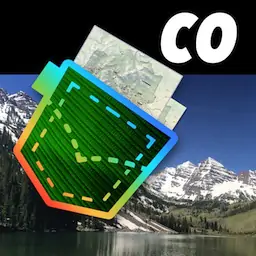"Scenic view from atop Twin Rock" by U.S. National Park Service , public domain
Geologic TrailFlorissant Fossil Beds |
featured in
| National Parks Pocket Maps |  | |
| Colorado Pocket Maps |  |
Florissant Fossil Beds
Geologic Trail
Florissant Valley is an ever changing landscape, shaped by the power of erosion, uplift and eruptions over
millions of years. Since the Proterozoic eon, Florissant had several episodes magmatic activity with the
emplacement of Pikes Peak pluton nearly one billion years ago, to the eruption around the Thirtymile
Volcanic field that ended Lake Florissant. Even today, water from Grape Creek continues to cut through
the rock strata beneath. Rain and snow are constantly eroding the landscape. The Geologic Trail helps you
see the tectonic history and erosive forces that have shaped Florissant valley.
1 Stop One – Eocene Lake Florissant
The trailhead of the
Geologic Trail begins
at the junction with
the Petrified Forest
Loop Trail going
1,000ft (300m)
northeast of the
visitor center. Follow
the map on the back
to see each stop. As
you walk to the junction, you will cross the 34 million year
old Florissant Formation along the bottom of what was once
Lake Florissant. Scale is 2in (5cm).
2 Stop Two – Ice Age Gravels
As the Geologic Trail ascends onto the low ridge, you will
notice that the ground is made up of gravel. The gravel
originates from decomposed granite that has been eroded by
water from the slopes of surrounding hills into the Florissant
valley. This overburden covers much of the Florissant
Formation in the monument, but is only a few feet deep. A
mammoth tooth (pictured right) and bones were discovered
nearby in this layer and have been radiocarbon dated to more
than 43,000 years ago (Late Pleistocene). At the time of the
discovery in 1994, it was one of the highest elevations (8400ft
or 2550m) at which an ice age mammoth had been found. A
much larger fossil site was discovered in in 2010 at
Snowmass, Colorado, 100 miles
west of here. The Snowmastodon
site provided over 5,000 fossils
from mammoths and mastodons
including a variety of smaller
animals. The Snowmass site
remains the highest altitude in the
world, 8900ft (2700m), at which
Pleistocene megafauna lived.
5cm
3 Stop Three – Grape Creek and Pikes Peak Granite
As you cross the bridge, you will see that Grape Creek is the
force that actively erodes and redeposits sediment, or
alluvium, along the stream channel. While most of the
sediment is relatively young, it underscores that geologic
processes never cease and rock is constantly being reworked.
From the bridge, you will see large boulders made of Pikes
Peak Granite. This rock unit formed over 1.08 billion years
ago deep beneath the surface, cooling over millions of years
before being uplifted. In geology, igneous rocks that form
underground with long cooling periods are plutonic. The
Pike’s Peak Granite forms a structure called a batholith,
which is a large intrusive igneous body that forms
underground over time as the magma cools. It is about 25
miles (40km) wide and 80 miles (130km) long, extending
from Castle Rock to just south past Colorado Springs.
4 Stop Four – Tuff Outcrop
After crossing the bridge, you will begin to ascend
the trail through a section of Wall Mountain Tuff.
The Wall Mountain Tuff formed 37 million years ago
as an ash flow that erupted from a caldera located
near modern Mount Princeton, about 50 miles
(80km) west of Florissant. This superheated ash
cloud settled to the ground, welded together and
cooled to form a rock called rhyolitic welded tuff.
This is an example of a volcanic rock, which is any
finely grained or glassy igneous rock that forms from
the rapid cooling of surface eruptions or extruded
lava.
.25 mi
Wall Mountain Tuff has a few small crystals visible
to the naked eye, but it is mostly fine-grained beige
material (groundmass). The visible crystals, or
phenocrysts, formed in the magma long before the
eruption. Meanwhile the microscopic crystals in the
groundmass can only be seen under a microscope.
The ash flow’s rapid cooling and explosiveness
prevented large crystals from forming; geologists call
this a pyroclastic texture.
Rhyolitic Tuff vs Granite: Is there a difference?
Qz
Qz
Qz
5
Rhyolitic welded tuff and granite may seem like two different
rocks, but they are actually more similar than they appear.
Rhyolitic tuff and granite share a similar chemistry, containing
about the same parts of the minerals quartz, feldspar and
amphibole. However, their crystal size and texture is what
determines each type of rock. Granite (right) took thousands
to millions of years to form phenocrysts whereas most of
rhyolitic welded tuff (left) cooled instantaneously, thereby
forming microscopic crystals. The photos to the left show the
different sizes of crystals seen on each rock. Notice the size
difference in the quartz (Qz) crystals on each rock. Scale is
1cm (.4 in).
Stop Five – Geologic Trail Overlook
Being the oldest rock in the monument, the Pikes Peak Granite is the foundation, or basement rock, of all overlying strata in the
Florissant region. As you reach the overlook at the end of the trail, you will notice that you cross a contact between the Wall
Mountain Tuff and Pikes Peak Granite. When the Wall Mountain Tuff was formed, it solidified over the Pikes Peak Granite.
In the distance you will see the modern Florissant valley and many surrounding ridges and peaks. In the late Eocene, lake
Florissant would have dominated the foreground with the Guffey volcanic center on the horizon . Today, those features have
been eroded or buried and replaced by new features, like Mt. Pisgah.


